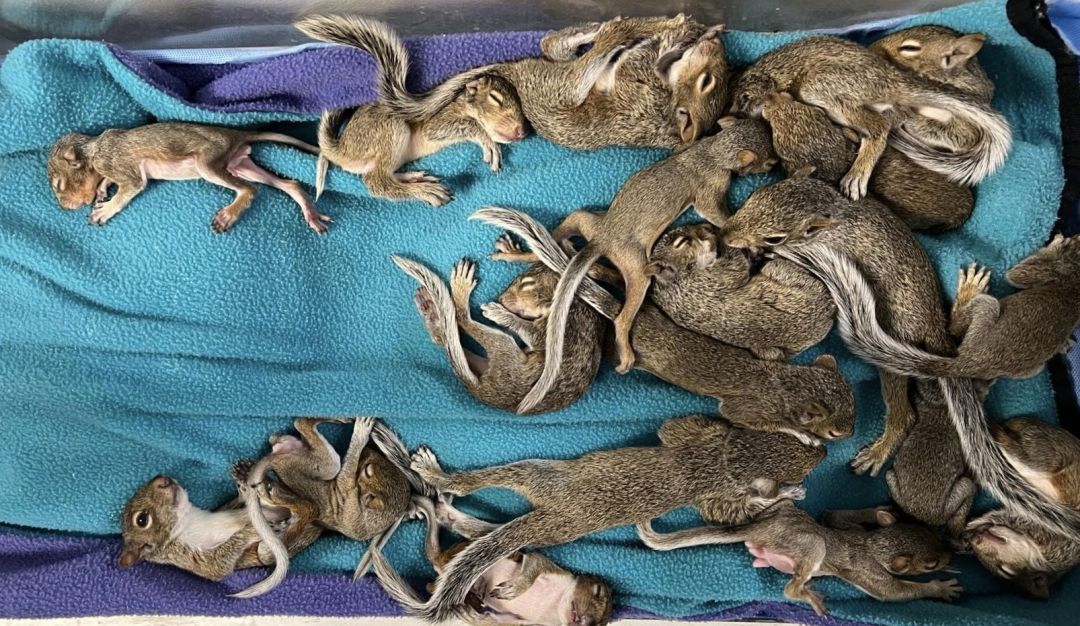Anna Maria's Wildlife Inc. Has Taken in a Flood of Animals Ravaged by Hurricane Ian

Roughly 20 pinkies stay warm amongst heating rocks in a repurposed fish tank at the Wildlife Inc. Education and Rehabilitation Center. Most pictured here are four weeks old.
Image: Courtesy Photo
You probably have two pinkies. But at the Wildlife Inc. Education and Rehabilitation Center on Anna Maria Island, volunteer Krista Carpenter has so many she stopped counting.
We're not talking about our smallest fingers—this is the squirrel kind.
Tender and tiny, "pinky" is the name for a baby squirrel, which Carpenter and 14 volunteers are caring for around the clock—“doing double duty,” she says—after Hurricane Ian blasted its way through their habitat. The storm ravaged the most vulnerable, like pinkies, who were likely separated from their mothers. Now, thanks to the kindhearted residents who found them and reached out to Wildlife Inc. in the days following the storm, they’re getting a second chance.
Carpenter says the morning after Ian, the center took in roughly 150 to 175 animals. Almost all were squirrels, with a few opossums and skunks, too. A litter of baby ducks couldn’t be saved. “I'd be lying if I told you they all made it," Carpenter says. "They were beaten up and cold. When people get to them, it’s later—while cutting into a tree during cleanup, for example.
“We had people drive all the way from Northport and Tampa because we were the only ones answering the phones,” she adds.
Center founders Ed and Gail Straight kept vigil at the shelter during the storm. Located in a residential neighborhood, the Anna Maria location is an extension of their home and started as a two-car garage in 1988.
"It just grew from there. Now they don't have a backyard because it’s all for the rescues,” Carpenter says.
With the electricity outage, the Straights used generators to power refrigerators to keep perishable feeding formulas cold and microwaves to warm them for feeding times—not to mention to keep thousands of dollars worth of raw meat and fish viable.
“Every other week, we spend $4,000 on frozen food for the animals. Losing that investment would have been crushing,” Carpenter says.
Owls and osprey eat frozen fish, chicken and rats. There are falcons that eat quail. The generators also powered incubators—six house roughly 20 animals in each, including skunks, opossums and raccoons.
This year, the center has cared for 2,350 animals thus far and, due to Hurricane Ian, expects to surpass last year's number, which was just over 3,000. New additions this year include a bobcat and a coyote.
But for now, the fragile pinkies are demanding the most care. "Our last feeding is 10 p.m. and the first is at 5 a.m.," Carpenter says. They're fed every two to six hours and the formula-fed ones—which are syringe or bottle-fed—are fed every two-and-a-half hours. Each pinky can take up to roughly five minutes to feed and it’s roughly six to 10 weeks before they can graduate to solids."
Their recovery "depends on how sick they are when they come to us, not unlike a human," she says. Many suffer upper respiratory infections that require antibiotics. They're a noisy crew, since “they squeak when they're hungry.”
Eventually, once the animals are strong enough, they're released on farms out east.
Due to the hurricane, the center's non-indigenous animals—including two tortoises in the front yard—were evacuated to Mixon Fruit Farm in Bradenton, which doubles as a licensed public education facility for the center. It houses wildlife ranging from African crocodiles to birds and mammals including a wildcat. Animals found to be terminally injured and non-releasable become part of the center’s education program. There’s a kestrel with a broken wing, and a screech owl, too. A great horned owl came to the center as a baby after it had ingested rat poison—which acts as a blood thinner—leading to a stroke and a lost eye. An albino corn snake and peregrine falcon are also part of Mixon's educational program traveling to schools and other events.
The center continually sends trained staff to assist and transport wildlife back to its location for care when necessary, free of charge. Like all of its services, the nonprofit is powered through donations and animal lovers like Carpenter.
If you find wildlife in need of care, click here. For regular updates on how the center's animals are doing and adorable animal videos, follow the Facebook page. To donate, volunteer or learn more about Wildlife Inc., click here.



